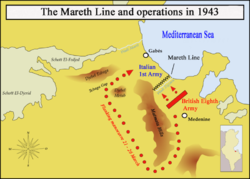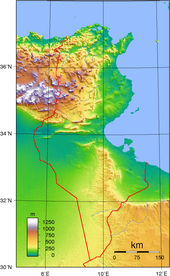
The Battle of Kasserine Pass took place from 18-24 February 1943 at Kasserine Pass, a 2-mile-wide (3.2 km) gap in the Grand Dorsal chain of the Atlas Mountains in west central Tunisia. It was a part of the Tunisian campaign of World War II.

The Tunisian campaign was a series of battles that took place in Tunisia during the North African campaign of the Second World War, between Axis and Allied forces from 17 November 1942 to 13 May 1943. The Allies consisted of British Imperial Forces, including a Greek contingent, with American and French corps. The battle opened with initial success by the German and Italian forces but the massive supply interdiction efforts led to the decisive defeat of the Axis. Over 250,000 German and Italian troops were taken as prisoners of war, including most of the Afrika Korps.

The Battle of El Guettar was a battle that took place during the Tunisia Campaign of World War II, fought between elements of the Army Group Africa under General Hans-Jürgen von Arnim, along with Italian First Army under General Giovanni Messe, and U.S. II Corps under Lieutenant General George Patton in south-central Tunisia. It was the first battle in which U.S. forces were able to defeat the experienced German tank units, but the followup to the battle was inconclusive.
This is a timeline of the North African campaign.

The Battle of the Mareth Line or the Battle of Mareth was an attack in the Second World War by the British Eighth Army in Tunisia, against the Mareth Line held by the Italo-German 1st Army. It was the first big operation by the Eighth Army since the Second Battle of El Alamein 4+1⁄2 months previously. On 19 March 1943, Operation Pugilist, the first British attack, established a bridgehead but a break-out attempt was defeated by Axis counter-attacks. Pugilist established an alternative route of attack and Operation Supercharge II, an outflanking manoeuvre via the Tebaga Gap was planned. Montgomery reinforced the flanking attack, which from 26 to 31 March, forced the 1st Army to retreat to Wadi Akarit, another 40 mi (64 km) back in Tunisia.

The Battle of Medenine was an Axis spoiling attack at Medenine in Tunisia on 6 March 1943. The operation was intended to delay an attack by the British Eighth Army on the Mareth Line. The British had been forewarned by Ultra decrypts of German wireless communications and rushed reinforcements from Tripoli and Benghazi before the Axis attack, which was a costly failure. General Erwin Rommel, the commander of Army Group Africa (Heeresgruppe Afrika), could not afford to lose forces needed for the defence of the Mareth Line and the effort was abandoned at dusk that day.
The 69th Infantry Brigade was an infantry brigade of the British Army in the Second World War. It was a second-line Territorial Army formation, and fought in the Battle of France with the 23rd (Northumbrian) Division. The brigade was later part of the 50th (Northumbrian) Infantry Division. It went on to fight in the North African campaign, the Allied invasion of Sicily, the Normandy landings and the North West Europe campaign.
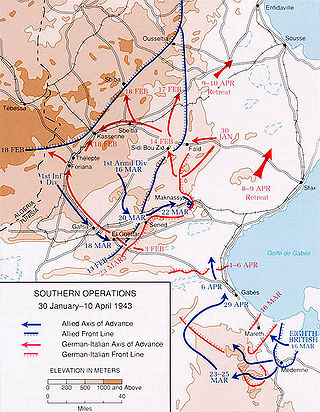
The Battle of Sidi Bou Zid(Unternehmen Frühlingswind/Operation Spring Breeze) took place during the Tunisia Campaign from 14–17 February 1943, in World War II. The battle was fought around Sidi Bou Zid, where a large number of US Army units were mauled by German and Italian forces. It resulted in the Axis forces recapturing the strategically important town of Sbeitla in central Tunisia.
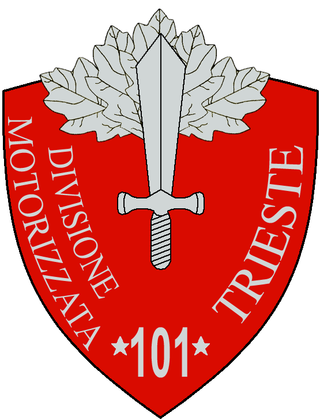
101st Motorized Division "Trieste" was a motorized infantry division of the Royal Italian Army during World War II. The Trieste was formed in 1939 and named for the city of Trieste. The division and its infantry and artillery regiments were based in Piacenza, while the 9th Bersaglieri Regiment was based until 1940 in Treviso and then moved to Cremona to be closer to the division. In September 1941 the Trieste was transferred to Libya for the Western Desert Campaign. The division was decimated in the Second Battle of El Alamein, but was rebuilt with the survivors of destroyed divisions. The Trieste then participated in the Tunisian Campaign until Axis forces in Tunisia surrendered to allied forces on 13 May 1943.

80th Infantry Division "La Spezia" was an infantry division of the Royal Italian Army during World War II. The La Spezia was formed on 15 November 1941 and named for the city of La Spezia. The La Spezia division was the only air-transportable division of the army and earmarked for the planned invasion of Malta. In November 1942 the division was sent to Libya to participate in the North African Campaign. On 13 May 1943 the La Spezia surrendered to Allied forces in Tunisia.

The 16th Infantry Division "Pistoia" was an infantry division of the Royal Italian Army during World War II. The division was named after the city of Pistoia and initially an infantry division, but reorganized to a fully motorized division in 1941. Consequently on 10 October 1941 the division was renamed 16th Motorized Division "Pistoia". The Pistoia had its recruiting area in the central Emilia-Romagna and its headquarters in Bologna. Its two infantry regiments were based in Bologna (35th) and Modena (36th), with the division's artillery regiment based in Bologna.
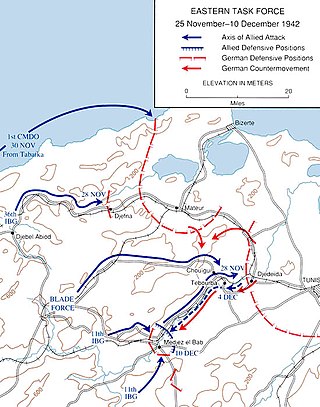
The Run for Tunis was part of the Tunisia Campaign which took place during November and December 1942 during the Second World War. Once French opposition to the Allied Operation Torch landings had ceased in mid-November, the Allies made a rapid advance by a division-sized force east from Algeria, to capture Tunis and forestall an Axis build up in Tunisia and narrowly failed. Some Allied troops were fewer than 20 miles (32 km) short of Tunis by late November but the defenders counter-attacked and pushed them back nearly 20 miles (32 km), to positions which had stabilised by the end of the year.
The 136th Armored Division "Giovani Fascisti" was an infantry division of the Royal Italian Army during World War II.
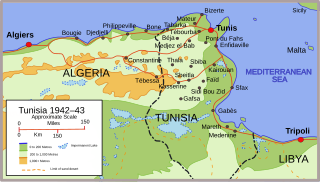
The Tebaga Gap of southern Tunisia is a low mountain pass located in rough rocky broken country giving entry to the inhabited coastal plain to the north and east from much less hospitable desert dominated terrain in southern and south-western Tunisia.

The Battle of Wadi Akarit was an Allied attack from 6 to 7 April 1943, to dislodge Axis forces from positions along the Wadi Akarit in Tunisia during the Tunisia Campaign of the Second World War. The Gabès Gap, north of the towns of Gabès and El Hamma, is a passage between the sea and impassable salt marshes. The 51st (Highland) Infantry Division breached the defences and held a bridgehead, allowing the passage of their main force to roll up the Axis defences. After several determined counter-attacks, the Axis forces withdrew and the Eighth Army, under General Bernard Montgomery, pursued toward Tunis, until reaching Axis defensive positions at Enfidaville.

The 2nd Battle of Longstop Hill or the Capture of Longstop Hill took place in Tunisia during the Tunisia Campaign of World War II from 21 to 23 April 1943. The battle was fought for control over the heights of Djebel el Ahmera and Djebel Rhar, together known as Longstop Hill and vicinity, between the British forces of the First Army and German units of the 5th Panzer Army. The infantry of the 78th Battleaxe Division and Churchill tanks of the North Irish Horse captured Longstop Hill after bitter fighting, in which the tanks created a measure of tactical surprise by driving up the hill, a manoeuvre that only Churchill tanks could achieve. The attackers broke through the German defences, which were the last great natural barrier on the road to Tunis.
Jebel Dahar is a low sandstone mountain chain of the Médenine Governorate of Tunisia.
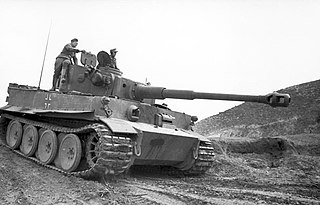
Unternehmen Ochsenkopf also known as the Battle of Sidi Nsir and the Battle of Hunts Gap was an Axis offensive operation in Tunisia from 26 February to 4 March 1943, during the Tunisia Campaign of the Second World War. The offensive and a subsidiary operation Unternehmen Ausladung was intended to gain control of Medjez el Bab, Béja, El Aroussa, Djebel Abiod and a position known as Hunt's Gap, between the British First Army and the Axis Army Group Africa. The offensive gained some ground, but none of the more ambitious objectives were achieved before the operation was called off due to increasing losses of infantry and tanks, particularly the heavy Tigers. Unternehmen Ochsenkopf was the last big Axis offensive by the 5th Panzer Army before the surrender of the Afrika Korps in May 1943.

Mareth museum is a military museum, in Mareth. Located between Gabes and Medenine, the Mareth line museum deals with the Second World War history. In March 1943, Rommel used this bunkered line to resist Montgomery's VIIIth army advance. The battle of the Mareth Line ensued. The Museum is built on a hill overlooking the Wadi Zigzaou, near several casemates which were strongpoints of the defensive line. Command posts, anti-tank and anti-aircraft guns are displayed outside the museum.

The Staffordshire Yeomanry, Royal Armoured Corps, was a tank regiment of Britain's Territorial Army converted from Yeomanry Cavalry serving in the Middle East during the Second World War. It fought at the Battles of Alam el Halfa and El Alamein in the Western Desert and the subsequent Tunisian campaign, distinguishing itself at the Battle of Tebaga Gap. It was then withdrawn to the UK to prepare for Operation Overlord, and landed on Sword Beach on D-Day. Subsequently, it was converted to operate amphibious tanks, and served in this role in the Battle of the Scheldt and the crossings of the Rhine and Elbe. Postwar, the Staffordshire Yeomanry remained part of the Royal Armoured Corps through various amalgamations.
